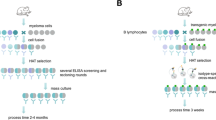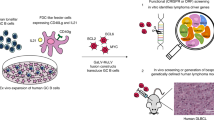Abstract
Transferrin receptors are expressed in large quantities on tissues with high requirements for iron such as maturing erythroid cells and placenta. In addition, they are found in abundance on proliferating cells from other normal tissues1–5 as well as on a variety of tumours4–8. Recent genetic analysis has shown that structural genes for the transferrin receptor, probably transferrin itself and for p97, a melanoma-associated antigen that exhibits primary sequence homology with transferrin and that can bind ferric iron, each map in man to chromosome 3 (refs 9–12). On this basis it has been suggested that there may be a region on chromosome 3 containing genes involved in Fe transport and that rearrangements in this region of chromosome 3 may in some circumstances be associated with malignant transformation12. Furthermore, it is unresolved whether all cell types express structurally identical transferrin receptors13,14. To study these problems, and as an initial step towards cloning the transferrin receptor gene, we describe here the derivation of mouse L-cell transformants expressing the human transferrin receptor.
This is a preview of subscription content, access via your institution
Access options
Subscribe to this journal
Receive 51 print issues and online access
$199.00 per year
only $3.90 per issue
Buy this article
- Purchase on Springer Link
- Instant access to full article PDF
Prices may be subject to local taxes which are calculated during checkout
Similar content being viewed by others
References
Larrick, J. W. & Creswell, P. J. supramolec. Struct. 11, 576–586 (1979).
Hamilton, T. A., Wada, H. G. & Sussman, H. H. Proc. natn. Acad. Sci. U.S.A. 76, 6406–6410 (1979).
Galbraith, G. M. P., Galbraith, R. M. & Faulk, W. P. Cell. Immun. 49, 215–222 (1980).
Trowbridge, I. S. & Omary, M. B. Proc. natn. Acad. Sci. U.S.A. 78, 3039–3043 (1981).
Sutherland, R. et al. Proc. natn. Acad. Sci. U.S.A. 78, 4515–4519 (1981).
Faulk, W. P., Hsi, B.-L. & Stevens, P L. Lancet II, 390–392 (1980).
Shindelman, J. E., Ortmeyer, A. E. & Sussman, H. H. Int. J. Cancer 27, 329–334 (1981).
Gatter, K. C., Brown, G., Trowbridge, I. S., Woolston, R.-E. & Mason, D. Y. J. clin. Path. 36, 539–545 (1983).
Goodfellow, P. M. et al. Somatic Cell Genet. 8, 197–206 (1982).
Enns, C. A., Soumaliainen, H. A., Gebhardt, J. E., Schroder, J. & Sussman, H. H. Proc. natn. Acad. Sci. U.S.A. 79, 3241–3245 (1982).
Miller, Y., Seligman, P., Jones, C., Patterson, D. & Scoggin, C. Clin. Res. 30, 41A (1982).
Plowman, G. D. et al. Nature 303, 70–72 (1983).
Lebman, D. et al. Blood 59, 671–678 (1982).
Stein, B. S. & Sussman, H. H. J. biol. Chem. 258, 2668–2673 (1983).
Enquist, L. W., Vandewoude, G. F., Wagner, M., Smiley, J. R. & Summers, W. C. Gene 7, 335–342 (1979).
Adams, R. A. et al. Expl Cell Res. 62, 5–10 (1970).
Graham, F. L. & Van Der Eb, A. J. Virology 52, 456–467 (1973).
Trowbridge, I. S. & Lopez, F. Proc. natn. Acad. Sci. U.S.A. 79, 1175–1179 (1982).
Reinherz, E. L., Kung, P. C., Goldstein, G., Levey, R. H. & Schlossman, S. F. Proc. natn. Acad. Sci. U.S.A. 77, 1588–1592 (1980).
Trowbridge, I. S. & Domingo, D. L. Cancer Surv. 1, 543–556 (1982).
Kavathas, P. & Herzenberg, L. A. Proc. natn. Acad. Sci. U.S.A. 80, 524–528 (1983).
Kit, S., Dubbs, D., Piekarski, L. & Hsu, T. Expl Cell Res. 31, 297–312 (1963).
Wigler, M., Pellicer, A., Silverstein, S. & Axel, R. Cell 14, 725–731 (1978).
Hyman, R., Trowbridge, I., Stallings, V. & Trotter, J. Immunogenetics 15, 413–420 (1982).
Trowbridge, I., Lesley, J., Schulte, R., Hyman, R. & Trotter, J. Immunogenetics 15, 299–312 (1982).
Salzman, G., Wilkns, S. & Whitfill, J. Cytometry 1, 337–341 (1981).
Laskey, R. A. & Mills, A. D. FEBS Lett. 82, 314–316 (1977).
Bates, G. W. & Schlaback, M. R. J. biol. Chem. 218, 3228–3232 (1973).
Author information
Authors and Affiliations
Rights and permissions
About this article
Cite this article
Newman, R., Domingo, D., Trotter, J. et al. Selection and properties of a mouse L-cell transformant expressing human transferrin receptor. Nature 304, 643–645 (1983). https://doi.org/10.1038/304643a0
Received:
Accepted:
Issue Date:
DOI: https://doi.org/10.1038/304643a0
This article is cited by
-
Diphtheria toxin-based targeted toxin therapy for brain tumors
Journal of Neuro-Oncology (2013)
-
Gene transfection of the HuLy-m2 (Leu-9) antigen into mouse L cells
Immunogenetics (1987)
-
Isolation of the CD7 gene from the DNA of transfected L cells
Immunogenetics (1987)
-
Selection and characterization of transferrin receptor mutants using receptor-specific antibodies
Immunogenetics (1986)
-
Expression and regulation of human low-density lipoprotein receptors in Chinese hamster ovary cells
Nature (1984)
Comments
By submitting a comment you agree to abide by our Terms and Community Guidelines. If you find something abusive or that does not comply with our terms or guidelines please flag it as inappropriate.



